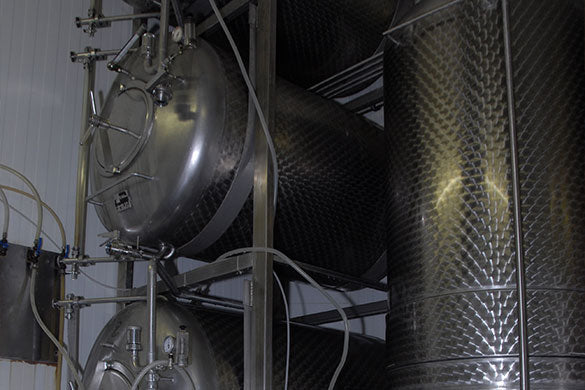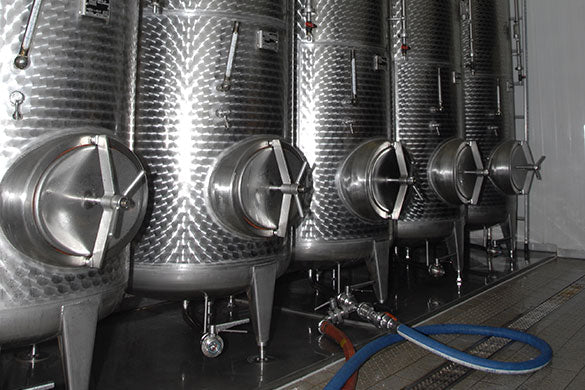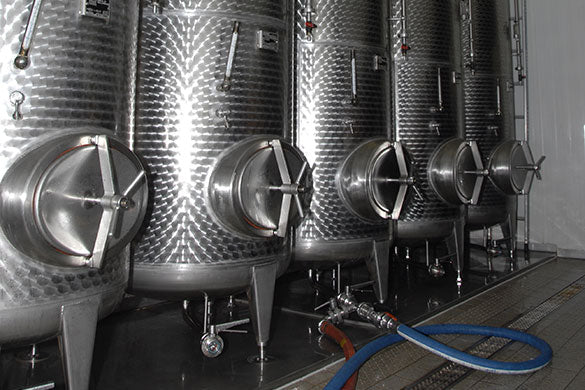Das Maischen
Zu Beginn des Brauprozesses wird das Braumalz, das in einem Malzsilo gelagert wird, in der Schrotmühle gemahlen. Anschließend wird das Malzschrot in der Maischepfanne mit Wasser zur so genannten Maische vermischt und danach dort auf verschiedenen Temperaturstufen erhitzt. Dabei wandeln die natürlichen Enzyme, die in den Malzkörnern enthalten sind, die wasserunlösliche Stärke des Getreides in löslichen Malzzucker um. Während dieser Phase des Brauprozesses gehen die für das Brauen wichtigen Stoffe des Malzes in die Lösung über.
Das
Läutern

The next step on the way to beer: the lauter tun. This is where the solid components of the mash are separated from the liquid. Brewers refer to this as the spent grain—primarily the hulls of the grains—and the wort, which contains all the soluble components of the malt. Only the wort flowing from the lauter tun, with its valuable constituents, now reaches the wort kettle.
Die
Würzepfanne

In the wort kettle, the hops are added to the liquid wort, which is then boiled for about an hour. The more hops the brewer adds (approximately 18 to 40 mg of bittering compounds per liter), the more hoppy—that is, more bitter or hoppy-aromatic—the finished beer will taste. Depending on the beer type, aroma or bittering hops are used.

The whirlpool/cooling
After this boiling in the wort kettle, any remaining turbidity is removed from the solution in the whirlpool. The wort is then cooled in the wort chiller before the yeast is added and fermentation can begin.

fermentation
In the fermentation tank, the yeast then does its job: It converts the malt sugar dissolved in the wort into carbon dioxide and alcohol. After the yeast has done its work, it is drawn off, and the so-called "young beer" is ready.

storage cellar
But before the beer is pumped into its final tank, the brewer gives it one last rest: It goes into the lager tank, which can last up to two months, depending on the beer type. Three things happen in the lager cellar: First, the beer's flavor rounds out; any remaining sugar is almost completely broken down, and unwanted aromas are expelled. Second, the carbon dioxide is absorbed, giving the young beer its effervescence. Third, the remaining yeast and protein flakes settle to the bottom, making the beer clearer.

Dispensing tanks
After the storage period, our beer is then ready to be consumed and enjoyed in our dispensing tanks.
Das
fertige Bier

The fine-pored white foam is as much a part of beer as a crown is of kings. Beer owes its enticing, appetizing freshness to the head. The length of time the delicate foam remains on the beer is an important criterion for the quality of this popular beverage. Foam formation, i.e., the height and consistency of the foam after pouring, also serves to assess the quality of the beer. A beautiful head is not the product of chemical additives, at least not in beers brewed according to the German Purity Law. The process by which the foam forms on the beer is pure nature.
Beer doesn't foam with anger
During the fermentation process, the yeast converts the maltose contained in the wort into alcohol and carbon dioxide. The carbon dioxide now dissolved in the beer is primarily responsible for the formation of the beer foam. The warmer the beer, the faster the carbon dioxide bubbles out of the beer. Beer that is too cold foams too little, while beer that is too warm foams too much. The temperature of the poured beer should therefore be between six and eight degrees. The moment the beer is poured into the glass, the carbon dioxide is released. There are two reasons for this: Firstly, the counterpressure that was built up during filling into the keg or bottle is eliminated. Secondly, the beer hits the sides of the glass. The more strongly this happens, the more the beer foams. If the beer hits the glass at an angle, the forces are less than if it hits the bottom of the glass directly. If you hold the glass at an angle while pouring, the beer will therefore foam less.
Since the carbon dioxide has now transformed into a gaseous state, countless fine bubbles rise to the surface when pouring. On their way to the top, molecules – primarily protein from the barley or wheat – adhere to the surface of the carbon dioxide bubbles. This creates elastic membranes around the bubbles. The bubbles also pull air and liquid upwards. This mixture settles on the surface of the beer and forms the creamy white beer foam that connoisseurs love so much. Unfortunately, even the most beautiful foamy splendor disappears again when the beer flows back out of the spaces between the bubbles and out of the now-burst bubbles themselves. This process is promoted by natural evaporation at the surface. The bitter substances in the hops are primarily responsible for the foam's longevity. They allow the carbon dioxide protein bubbles to react with each other and form complexes - essentially sticking together - so that the bubbles do not burst so quickly.

